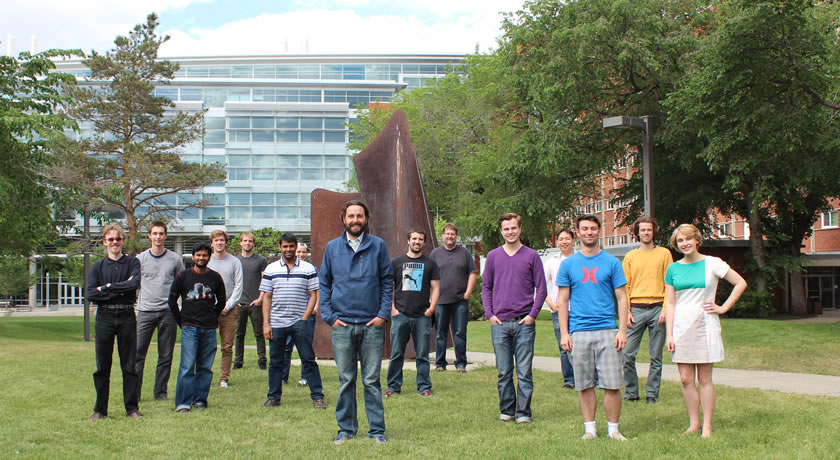
From left to right: Dylan Darnell, Hugh Ramp, Tushar Biswas, Pearse Doolin, Callum Doolin, Md. Ruhul Amin, Allison MacDonald, John P. Davis, Brad Hauer, Greg Popowich, Clinton Potts, Paul Kim, Tommy Clark, Fabien Souris, Holly Christiani. Photo by Ross Lockwood.
(Edmonton) The intersection of pure science and application-driven research is an exciting thing. Quantum mechanics has for years been a science primarily dedicated the pursuit of knowledge. Within the last decade or so, that has changed. John Davis, Assistant Professor in the Department of Physics, is exploring the quantum properties of tiny nanomechanical resonators. These miniscule structures could make a huge impact on modern computing.
The nanoresonators that Davis builds typically contain only 1012 atoms. While these resonators remain on the small side (our bodies are composed of roughly 7 x 1027 atoms!), they are much larger than the objects in which quantum phenomena are normally observed. Yet Davis and his team are eliciting quantum mechanical behaviour out of their nanomechanical resonators, scaling quantum effects up from the sub-atomic to the nanoscale realm.
"Once we have a nanoscale object that we are interested in, we have to be able to precisely measure it," says Davis. This involves lowering the temperature of the object in order to observe quantum effects. The temperatures at which Davis conducts his research are typically very close to absolute zero. "When matter is cooled to low temperatures new properties often emerge because, as the thermal energy of a system is reduced, other lower energy effects become increasingly important," says Davis.
Davis explains that he and his team "are working to develop technology that interfaces with quantum computers and aids in quantum information transfer."
"We are pretty confident that the future of quantum computing is based around something called a superconducting microwave resonator," says Davis. Microwaves can be used in quantum computing to gather the information from superconducting qubits. The trick is that the whole system must be cooled in order to decrease thermal energy, which allows quantum effects to come into play.
The nanoresonators and related structures that Davis is investigating are helping to lay the groundwork required for real-world exploitation of quantum phenomena.
"These microwaves are 'delicate' in that they are hard to get out of the extremely low temperature environment in which they are used, and it's even harder to interface these with the optical fibers that are used for telecommunication and quantum cryptography. Building a convertor from microwave wavelengths to communication wavelengths could provide a missing link between quantum computers and quantum cryptography - two key technologies in the coming years."
The miniscule nanoresonators that Davis builds are not easy to make. He uses the nanoFab facility at the Faculty of Engineering, which "allows us to use electron beam lithography to pattern and develop our devices in multilayered silicon or silicon-compound based wafers." Davis notes that this process often takes months to complete.
"We are working at the limitations of these fabrication tools, and soon may start looking at even higher-end nanofabs to perform certain critical steps." Such nanotechnological developments may one day foster a literal "quantum leap" in computing power.